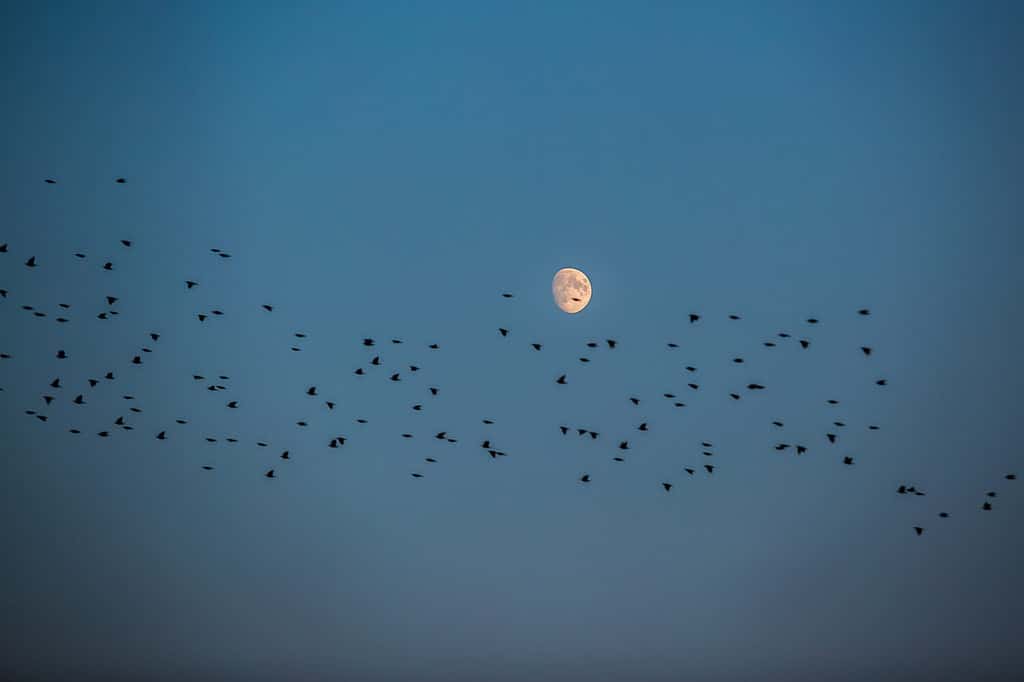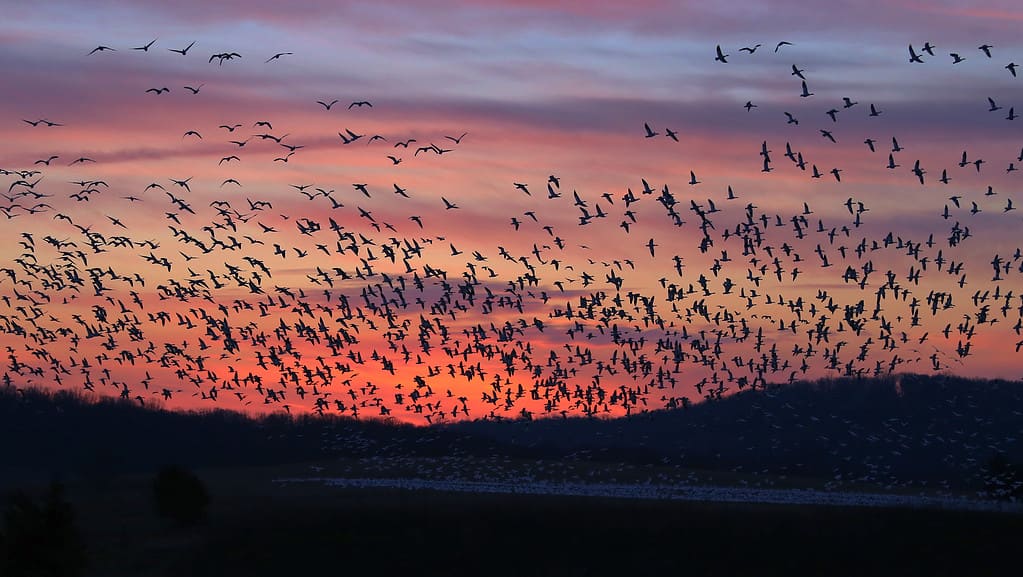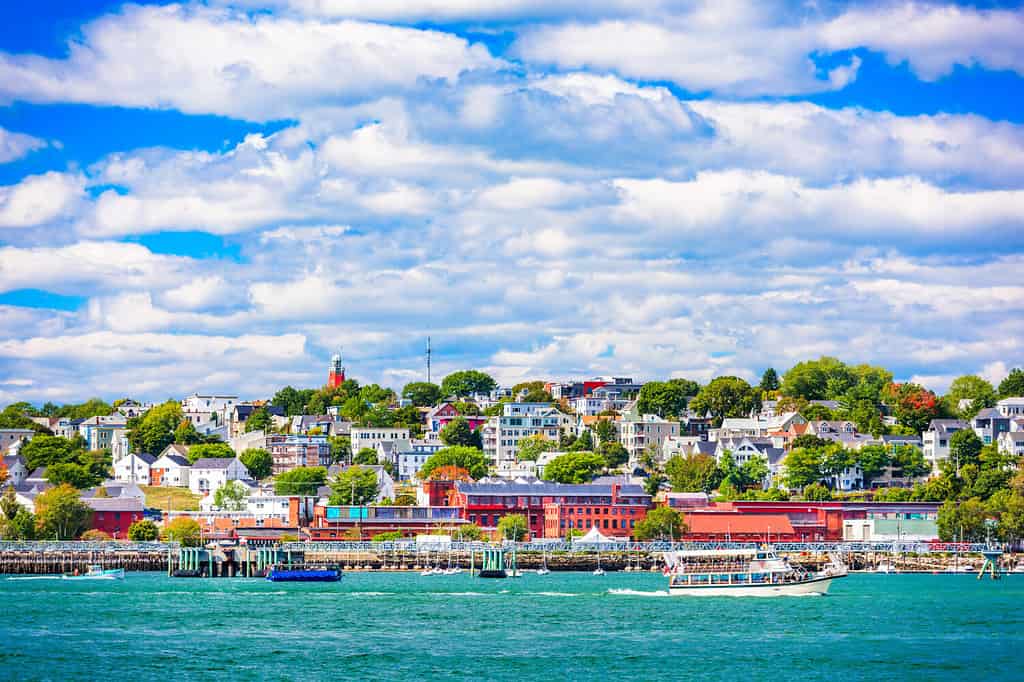
The post How Light Pollution Harms Migrating Birds appeared first on A-Z Animals.
Light pollution is a man-made problem caused by the excessive use of artificial lights, especially at night. These lights can disrupt natural sleep cycles, waste energy, and even mislead migratory animals, which can be detrimental. Some common examples of light pollution include streetlights, bright advertisements, and even porch lights.
Wondering how light pollution affects migratory birds? Keep reading to hear an expert’s insight, as well as ways you can help.
Impacts of Light Pollution

Many migratory birds travel at night, using the moon and stars as their guides.
©Lioneska/Shutterstock.com
Here are two prominent impacts of light pollution to consider:
It Disrupts Natural Cycles
Light pollution isn’t just an issue for humans and the environment. In fact, it causes major trouble for wildlife by disrupting their natural cycles.
“Just like humans, wildlife operates on circadian clocks tied to natural light—dark cycles, telling them when to sleep, eat, and carry out all the behind-the-scenes work to survive,” says Dr. Rae Wynn-Grant, Wildlife Ecologist and Co-Host at Mutual of Omaha’s Wild Kingdom Protecting the Wild. “Nocturnal species are active at night because their bodies are tuned to darkness. When we introduce artificial light, we’re sending mixed signals to their biology.”
Naturally, this leads to a variety of issues for the animals—especially migratory birds that rely on natural cues along their journeys.
“This can throw off hormone production, including melatonin, which plays a key role in regulating sleep, immune function, and reproduction,” she continues. “It’s not just about one bat or one bird losing a night’s sleep; it’s about entire populations slowly getting out of step with the natural world they depend on.”
While you might assume nocturnal animals are safe from light pollution, as they don’t require rest during nighttime hours, this is far from true.
“Nocturnal animals also navigate by cues of moonlight and starlight,” Wynn-Grant explains. “When we introduce artificial lighting into their habitats, it can throw them off course, causing them to wander into unsafe areas and expend energy they need for survival.”
It Messes With Pollination
According to Wynn-Grant, “One of the lesser-known impacts of leaving a porch light on is what it does to pollination at night.”
Pollination does not just occur during daylight. In fact, much of it happens late into the evening, after the sun sets and the moon rises.
“People think of bees when they think of pollinators, but there’s this whole other world of night pollinators, including moths, beetles, and even some flies that quietly keep ecosystems running after the sun goes down,” Wynn-Grant continues. “These species are important for certain plants that only bloom or release their scent at night. When we leave lights on, insects can avoid the illuminated area altogether, or they get distracted and trapped near the light instead of visiting flowers.”
If you’ve ever left a porch light on, you’ve likely seen the swarm of insects, like moths, gathering around it.
“Over time, that can turn a yard or neighborhood into what we call a ‘pollination desert’ where plants aren’t getting the visits they need to reproduce,” she says. “The ripple effect means fewer seeds and fruits for wildlife, lower plant diversity, and could shift the larger ecosystem.
Nocturnal species are active at night because their bodies are tuned to darkness. When we introduce artificial light, we’re sending mixed signals to their biology.
Dr. Rae Wynn-Grant, Wildlife Ecologist and Co-Host at Mutual of Omaha’s Wild Kingdom Protecting the Wild
How Light Pollution Impacts Migratory Birds

Middle Creek Wildlife Management Area is a stop on the long migration of snow geese every year
©Bo Shen/iStock via Getty Images
According to the U.S. Fish & Wildlife Service (FWS), nighttime lighting can attract birds from as far as 5 kilometers away. Not only does this guide them away from their migratory paths, but it also depletes their energy and risks deadly collisions.
“Many migratory birds travel at night, using the moonlight and the Earth’s magnetic field to orient themselves,” says Wynn-Grant. “Artificial lights, even small porch lights, can confuse them, pulling them off course or causing them to circle repeatedly. Disoriented birds can end up flying toward lit windows, seeing reflections of trees or sky, and collide at high speeds.”
If you must use nighttime lighting, she recommends using motion-activated lights as an alternative to consistently bright bulbs. These lights only turn on when triggered by movement, making them less disruptive compared to other lighting, which stays on throughout the night.
Where Is Light Pollution the Worst?

Coastal towns often cause light pollution at night.
©Sean Pavone/Shutterstock.com
Unsurprisingly, light pollution tends to be the worst in highly populated urban areas, like big cities that never sleep. That’s why it’s difficult to stargaze in such regions. However, according to Wynn-Grant, coastal towns are also culprits of light pollution.
“Artificial lighting in coastal towns can have a big impact on aquatic and shoreline wildlife,” she says. “Certain species rely on the natural glow of moonlight and starlight reflecting on the water to find their way.”
For example, sea turtle hatchlings often look to the moon for guidance, but when there’s too much light pollution, they often can’t find their way.
“When artificial lights compete with or overpower those natural cues, hatchlings can end up heading inland, where they quickly become vulnerable to dehydration and predators,” she says.
How to Help Reduce Light Pollution

Your efforts can make more of an impact than you realize.
©GizemG/Shutterstock.com
Now that you know the negative impacts of this detrimental man-made issue, consider the ways you can help.
“Turning off your porch lights at night helps more than your local ecosystem,” says Wynn-Grant. “By setting your lights to a timer or using motion-censored lighting, you’re conserving energy, reducing greenhouse gas emissions, and decreasing pollution.”
It really is that simple. “It may seem like a small effort, but when you think about all the porch lights in just one neighborhood, this tiny task can compound to make a true difference in our global environment,” she says.
The FWS also recommends closing blinds to reduce indoor light spilling outside, avoiding upward-facing lights, and using warmer colored light (like amber and orange).
The post How Light Pollution Harms Migrating Birds appeared first on A-Z Animals.
November 23, 2025 at 06:32PMSammi Caramela
.jpeg)
.jpeg)

0 Comments